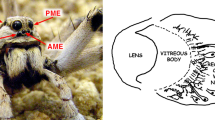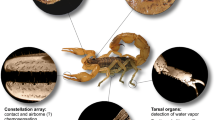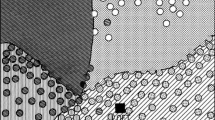Abstract
Adult male Leucorchestris arenicola can walk round-trips of several tens of meters in search of females. Most excursions end with the spiders returning to their burrow. For small animals homing over distances of several meters is theoretically impossible without the aid of external cues. It was investigated, whether the spiders use local cues or they rely solely on global cues. Individually marked male spiders were captured during their excursions and displaced several meters inside an opaque box. Ten out of twelve displaced spiders returned to their burrows. This shows that the male L. arenicola are using local cues during their homing, as the comparatively small displacement distances could not be detected by means of global, e.g. celestial cues. In order to test whether the spiders could be using olfactory guidance, the burrows were displaced by 2 m while the spiders were out on their journeys. In 12 out of 15 experiments, the spiders did not find their burrows. These results show that the burrows do not function as olfactory beacons for the homing spiders.


Similar content being viewed by others
References
Bartels M (1929) Sinnesphysiologische und physiologische Untersuchungen an der Trichterspinne Agelena labyrinthica (Cl.). Z Vergl Physiol 10:527–591
Barth FG, Nakagawa T, Eguchi E (1993) Vision in the ctenid spider Cupiennius salei: spectral range and absolute sensitivity. J Exp Biol 181:63–79
Benhamou S, Sauvé JP, Bovet P (1990) Spatial memory in large scale movements: efficiency and limitation of the egocentric coding process. J Theor Biol 145:1–12
Birkhofer K, Scheu S, Henschel JR (2006) Does territorial behaviour in the desert-living spider Leucorchestris arenicola (Araneae: Sparassidae) affect its spatial distribution? Bull Br Arachnol Soc 13:341–346
Boles LC, Lohmann KJ (2003) True navigation and magnetic maps in spiny lobsters. Nature 421:60–63
Dacke M., Nilsson DE, Warrant EJ, Blest AD, Land MF, O’Carroll DC (1999) Built-in polarizers form part of a compass organ in spiders. Nature 401:470–473
Dacke M, Nordström P, Sholtz CH (2003) Twilight orientation to polarised light in the crepuscular dung beetle Scarabaeus zambesianus. J Exp Biol 206:1535–1543
Doujak FE (1985) Can a shore crab see a star? J Exp Biol 116:385–393
von Frisch K (1967) The dance language and orientation of bees. The Belknap Press of Harvard University Press, Cambridge
Fukushi T (2001) Homing in wood ants, Formica japonica: use of the skyline panorama. J Exp Biol 204:2063–2072
Fukushi T, Wehner R (2004) Navigation in wood ants Formica japonica: context dependent use of landmarks. J Exp Biol 207:3431–3439
Henschel JR (1990) The biology of Leucorchestris arenicola (Areneae: Heteropodidae), a burrowing spider of the Namib Desert. In: Seely MK (ed) Namib ecology: 25 years of Namib research. Transvaal museum monograph no. 7. Transvaal Museum, Pretoria, pp 115–127
Henschel JR (1994) Diet and foraging behaviour of huntsman spiders in the Namib dunes (Araneae: Heteropodidae). J Zool (Lond) 234:239–251
Henschel JR (2002) Long distance wandering and mating by the dancing white lady spider (Leucorchestris arenicola) (Araneae, Sparassidae) across Namib dunes. J Arachnol 30:321–330
Hill DE (1979) Orientation by jumping spiders of the genus Phidippus (Arenae: Salticidae). Behav Ecol Sociobiol 5:301–322
Laughlin S, Blest AD, Stowe S (1980) The sensitivity of receptors in the posterior median eye of the nocturnal spider, Dinopis. J Comp Physiol A 141:53–65
Mittelstaedt H (1985) Analytical cybernetics of spider navigation. In: Barth FG (ed) Neurobiology of arachnids. Springer, Berlin Heidelberg New York, pp 298–316
Müller M, Wehner R (1988) Path integration in desert ants, Cataglyphis fortis. Proc Natl Acad Sci USA 85:5287–5290
Müller M, Wehner R (1994) The hidden spiral: systematic search and path integration in desert ants, Cataglyphis fortis. J Comp Physiol A 175:525–530
Nørgaard T (2006) Nocturnal navigation in Leucorchestris arenicola (Araneae: Sparassidae). J Arachnol 33:533–540
Nørgaard T, Henschel JR, Wehner R (2003) Long-distance navigation in the wandering desert spider Leucorchestris arenicola: can the slope of the dune surface provide a compass cue? J Comp Physiol A 189:801–809
Nørgaard T, Henschel JR, Wehner R (2006a) The night-time temporal window of locomotor activity in the Namib Desert long-distance wandering spider, Leucorchestris arenicola. J Comp Physiol A 192:365–372
Nørgaard T, Henschel JR, Wehner R (2006b) Tracking the Namib Desert spider Leucorchestris arenicola—reading the story in the sand. Senckenb Biol 86:211–218
Papke MD, Reichert SE, Schulz S (2001) An airborne female pheromone associated with male attraction and courtship in a desert spider. Anim Behav 61:877–886
Robinson MD, Seely MK (1980) Physical and biotic environments of the southern Namib dune ecosystem. J Arid Environ 3:183–203
Rossel S, Wehner R (1986) Polarization vision in bees. Nature 323:128–131
Santschi (1911) Observations et remarques critiques sur le mécanisme de l’orientation chez les fourmis. Rev Suisse Zool 19:305–338
Seyfarth EA, Hergenröder R, Ebbes H, Barth FG (1982) Ideothetic orientation of a wandering spider: compensation of detours and estimates of goal distance. Behav Ecol Sociobiol 11:139–148
Tongiorgi P (1969) Evidence of a moon orientation in the wolf spider Arctosa variana C. L. Koch (Araneae, Lycosidae). Bull Mus Nat Hist Natur Paris 41:243–249
Vollrath F (1986) Gravity as an orientation guide during web-construction in the orb spider Araneus diadematus (Araneae, Araneidae). J Comp Physiol A 159:275–280
Warrant EJ (1999) Seeing better at night: life style, eye design and the optimum strategy of spatial and temporal summation. Vision Res 39:1611–1630
Warrant EJ (2004) Vision in the dimmest habitats on earth. J Comp Physiol A 190:765–789
Wehner R (1976) Polarized-light navigation by insects. Sci Am 235:106–115
Wehner R (1992) Arthropods. In: Papi F (ed) Animal homing. Chapman & Hall, London, pp 45–144
Wehner R (1994) The polarization-vision project: championing organismic biology. Fortschr Zool 39:103–143
Wehner R (1997) The ant’s celestial compass system: spectral and polarization channels. In: Lehrer M (ed) Orientation and communication in arthropods. Birkhäuser Verlag, Basel, pp 145–185
Wehner R (2003) Desert ant navigation: how miniature brains solve complex tasks. J Comp Physiol A 189:579–588
Wehner R, Duelli P (1971) The spatial orientation of desert ants, Cataglyphis bicolour, before sunrise and after sunset. Experientia 27:1364–1366
Wehner R, Michel B, Antonsen P (1996) Visual navigation in insects: coupling of egocentric and geocentric information. J Exp Biol 199:129–140
Wehner R, Srinivasan MV (1981) Searching behaviour of desert ants, genus Cataglyphis (Formicidae, Hymenoptera). J Comp Physiol A 142:315–338
Wehner R, Srinivasan MV (2003) Path integration in insects. In: Jeffery KJ (ed) The neurobiology of spatial behaviour. Oxford University Press, Oxford, pp 9–30
Wehner R, Wehner S (1986) Path integration in desert ants. Approaching a long-standing puzzle in insect navigation. Monit Zool Ital 20:309–331
Wehner R, Wehner S (1990) Insect navigation: use of maps or Ariadne’s thread? Ethol Ecol Evol 2:27–48
Wehner R, Gallizzi K, Frei C, Vesely M (2002) Calibration processes in the desert ant navigation: vector courses and systematic search. J Comp Physiol A 188:683–693
Wehner R, Boyer M, Loertscher F, Sommer S, Menzi U (2006) Ant navigation: one-way routes rather than maps. Curr Biol 16:75–79
Acknowledgments
We thank the Namibian Ministry of Environment and Tourism and the Gobabeb Training & Research Centre for permission to work in the Namib-Naukluft Park and for the use of facilities. This work was supported by the Swiss National Science Foundation (grant no. 31-61844.00 to R.W.) and the Department of Zoology, University of Zürich.
Author information
Authors and Affiliations
Corresponding author
Rights and permissions
About this article
Cite this article
Nørgaard, T., Henschel, J.R. & Wehner, R. Use of local cues in the night-time navigation of the wandering desert spider Leucorchestris arenicola (Araneae, Sparassidae). J Comp Physiol A 193, 217–222 (2007). https://doi.org/10.1007/s00359-006-0178-6
Received:
Revised:
Accepted:
Published:
Issue Date:
DOI: https://doi.org/10.1007/s00359-006-0178-6




